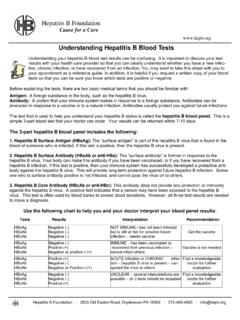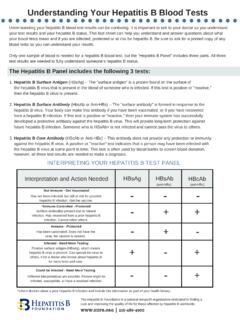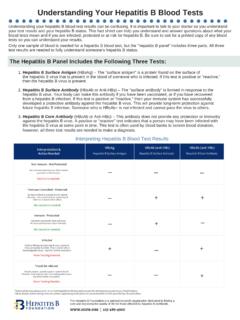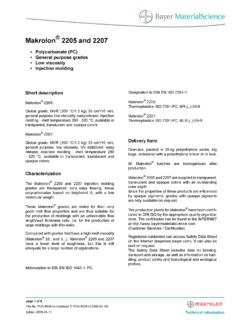Transcription of Treatment of Children With Chronic Hepatitis B Virus ...
1 MEETING REPORT. Treatment of Children With Chronic Hepatitis B Virus Infection in the United states : Patient selection and therapeutic options Maureen M. Jonas,1 Joan M. Block,2 Barbara A. Haber,3 Saul J. Karpen,4 W. Thomas London,5. Karen F. Murray,6 Michael R. Narkewicz,7 Philip Rosenthal,8 Kathleen B. Schwarz,9 and Brian J. McMahon10. Chronic Hepatitis B Virus (HBV) infection in Children presents a therapeutic challenge for the practitioner. Decisions regarding selection of patients who may bene t from Treatment , appropriate timing of Treatment , and the choice of antiviral therapy are complex and are compounded by the limited number of drugs that have been studied in Children . An expert panel of nationally recognized pediatric liver specialists was convened by the Hepatitis B.
2 Foundation on August 11, 2009, to consider clinical practice relative to the therapeutic options available for Children . A detailed account of these discussions is provided, and the opinions expressed are based on consensus of the experts, as well as on published evidence when available. The panel concludes that, at this time, there is no established bene t of Treatment of Children in the immune tolerant phase, and there is a very high risk of devel- opment of drug resistance. In addition, there is no indication for Treatment of Children in the inactive carrier state. For Children in the immune active or reactivation phases, liver histology can help guide Treatment decisions, and family history of liver disease, especially hepatocellular carcinoma, may argue for early Treatment in some cases.
3 Outside of clinical trials, interferon is the agent of choice in most cases. Nucleos(t)ide analogues are second- ary therapies, and Children who receive these agents require careful monitoring for devel- opment of resistance. There are a few situations when Treatment is indicated regardless of HBV DNA or alanine aminotransferase levels. There is still much to be elucidated about the appropriate use of HBV therapy in Children . Until more clinical data and therapeutic options are available, a conservative approach is warranted. (HEPATOLOGY 2010;000:000-000.). T. here are several published national and interna- practitioners is the limited number of drugs that have tional guidelines regarding the management of been studied and labeled for use in Children .
4 Adults with Chronic Hepatitis B Virus (HBV) Previously, an expert panel of nationally recognized infection,1 4 but standards for the Treatment of chil- pediatric liver specialists convened by the Hepatitis B. dren are still evolving. The decision to treat involves Foundation in November 2008 called for more con- numerous factors such as the age of the child, the se- sistent monitoring and referral of Children chronically verity of liver disease, medical cofactors, and family infected with HBV, emphasizing that any child with history of liver disease or liver cancer. In addition to elevated serum alanine aminotransferase (ALT) levels determining whom to treat, and when and for how and/or elevated alpha-fetoprotein (AFP) levels and/or a long they should be treated, a particular challenge for family history of liver disease or liver cancer should be Abbreviations: AFP, alpha-fetoprotein; ALT, alanine aminotransferase; AST, aspartate aminotransferase; HBeAg, Hepatitis B e antigen; HBsAg, Hepatitis B.
5 Surface antigen; HBV, Hepatitis B Virus ; HCC, hepatocellular carcinoma; HIV, human immunode ciency Virus ; IFN, interferon; PCR, polymerase chain reaction;. ULN, upper limit of normal; peginterferon, peg-IFN. From the 1 Division of Gastroenterology, Children 's Hospital Boston, Boston, MA; 2 Hepatitis B Foundation, Doylestown, PA; 3 Department of Pediatrics, Division of Gastroenterology, Hepatology and Nutrition, Children 's Hospital of Philadelphia, Philadelphia, PA; 4 Department of Pediatrics/Gastroenterology, Hepatology and Nutrition, Baylor College of Medicine, Houston, TX; 5 Fox Chase Cancer Center, Philadelphia, PA; 6 Division of Gastroenterology and Hepatology, Seattle Children 's and University of Washington School of Medicine, Seattle, WA.
6 7 Department of Pediatrics, Section of Pediatric Gastroenterology, Hepatology and Nutrition and The Pediatric Liver Center, University of Colorado Denver School of Medicine and The Children 's Hospital, Aurora, CO; 8 Pediatric Hepatology, University of California San Francisco, San Francisco, CA; 9 Department of Pediatrics, Division of Pediatric Gastroenterology and Nutrition, The Pediatric Liver Center, Johns Hopkins University School of Medicine, Baltimore, MD; 10 Liver Disease and Hepatitis Program, Alaska Native Tribal Health Consortium, Alaska Native Medical Center, Anchorage, AK. Received February 11, 2010; accepted April 8, 2010. 1. 2 JONAS ET AL. HEPATOLOGY, Month 2010. referred to a pediatric liver The panel adolescence.
7 The rates of spontaneous Hepatitis B e assembled for a second meeting on August 11, 2009, antigen (HBeAg) seroconversion (loss of HBeAg and to review the status of clinical practice relative to the development of anti-HBe) for vertically infected chil- therapeutic options available for Children , and to high- dren is less than 2% per year for those under age 3, light gaps in knowledge and areas for future study. and 4%-5% per year in Children older than 3 The following is based on consensus of expert opinion Children infected horizontally (after the perinatal pe- and published evidence when available. riod), have much higher rates of spontaneous serocon- version; 70%-80% seroconvert from HBeAg-positive to anti-HBe over 20 Natural History of HBV Infection Children who are in the immune active phase, with in Children persistently abnormal ALT levels and histologic nd- Because most infants born in the United states are ings of liver in ammation and brosis, are usually now vaccinated against HBV, the incidence of acute asymptomatic.
8 However, studies in adults suggest that infection has decreased Children at risk a prolonged period of time in the immune active for HBV infection include those who were not vacci- phase is associated with an increased risk of cirrhosis nated, had an inadequate response to perinatal treat- and Routine, lifelong monitoring for pro- ment or vaccination, or were exposed prior to being vac- gression of disease and potential opportunities to treat cinated. Immigrants from endemic areas and infants is In addition, all persons with Chronic HBV. who are born to HBV-infected mothers but do not infection are at risk for HCC, and should be followed receive immunoprophylaxis or vaccine in a timely fash- using the American Association for the Study of Liver ion are at particular risk, as are infants born to mothers Diseases Practice Guideline on with HBV DNA levels >20 million IU/mL in whom immunoprophylaxis and/or immunization is not always Approximately 90% of Children infected as Goals of Treatment infants, and 25%-50% of Children who become infected The current goals of therapy are to suppress viral after early infancy but before 5 years of age, will develop replication, reduce liver in ammation, and reverse liver Chronic Only 5%-10% of those who brosis.
9 And thereby protect the liver. Treatment is become infected with HBV as teens or adults progress geared toward reducing viral load until serum HBV. to Chronic Most adults with Chronic HBV DNA levels become undetectable by a sensitive poly- infection acquired the infection in infancy or early merase chain reaction (PCR) assay and, for patients childhood. Although most Children with Chronic HBV who are HBeAg-positive, achieving durable HBeAg infection are asymptomatic and severe liver disease dur- seroconversion. Another desirable endpoint is normal- ing childhood is rare, they are at risk for developing seri- ization of ALT level, indicative of improvement in ous complications later in life, including cirrhosis and liver histology.
10 HBsAg seroconversion occurs in a mi- hepatocellular carcinoma (HCC). nority of persons receiving Treatment , but it is the ulti- Chronic HBV infection, de ned as seropositivity for mate therapeutic goal because the risk of HCC is Hepatitis B surface antigen (HBsAg) for more than 6 reduced, although not necessarily The months, is characterized by four immunologic phases long-term clinical impact of early therapeutic HBeAg of disease (Table 1).11,12 Most Children will remain in seroconversion on the risk of complications later in life the immune tolerant phase until late childhood or is unknown. A prospective observational study in more The workshop was convened and funded by the Hepatitis B Foundation ( ) from its general operating funds.
















